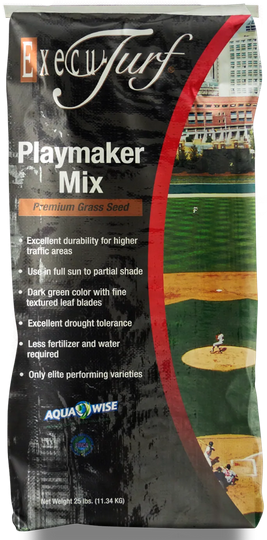The following two mixes/blends work well in full sun to partial shade.
They give you the best opportunity for success in high-traffic, sandy soil, or low-water situations.
1. Tuff Turf Blend
FORMULATION
100% Proprietary Turf-Type Tall Fescue
(3 rhizomatous type varieties – eg. SRP, LS, AST)
Lateral spread/self-repairing cultivars
SEEDING RATE
New Lawn: 8-10 lbs/1,000 sq. ft. or 425 lbs/A
Overseeding: 4-5 lbs/sq. ft.
Tuff Turf Blend provides a beautiful, dark, lush green lawn in the sun or shade. The newer turf-type tall fescue varieties are dark green and finer-bladed and include only elite varieties.

NOTABLE CHARACTERISTICS
Excellent performance and turf quality
Dark green color with finer leaf blades
Use in full sun or partial shade
Improved drought tolerance
Excellent disease resistance
Medium maintenance required
2. Playmaker Mix
FORMULATION
80% Turf-Type Tall Fescue (3 elite varieties)
10% Turf-Type Perennial Ryegrass (elite variety)
10% Kentucky Bluegrass (elite variety)
SEEDING RATE
New Lawn: 8-10 lbs/1,000 sq. ft. or 425 lbs/A
Overseeding: 4-5 lbs/sq. ft.
Playmaker Mix is comprised of beautiful yet durable turf-type tall fescues, elite Kentucky bluegrass, and top-quality perennial ryegrass. All varieties are selected for wear, traffic tolerance, and overall turf quality.

NOTABLE CHARACTERISTICS
Dark green color
Fine textured leaf blades
Excellent durability for high-traffic areas
Fantastic drought tolerance
Deep root structure
Outstanding disease resistance
Less fertilizer is required than for other elite mixes
Less water is required than for other elite mixes
Use in full sun to partial shade
Notes on Turf-Type Tall Fescue
The latest varieties of turf-type tall fescue are durable, drought-tolerant grasses that are much more dark green and fine-bladed than the tall fescues of the past. The elite varieties in Tuff Turf and Playmaker have a dark green color with excellent turf quality, similar to Kentucky bluegrass and perennial ryegrass.